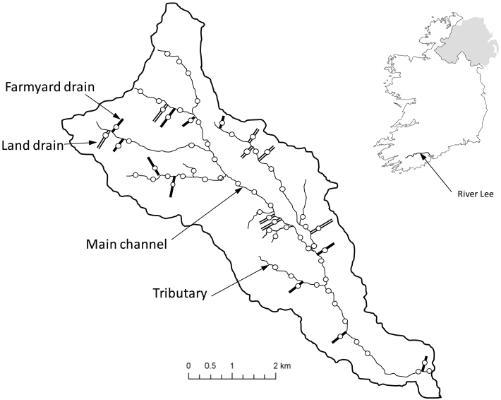In This Section
New article in Science of the Total Environment by Dr Tim Sullivan!

MESA Principal Investigator, Dr Tim Sullivan, has co-authored a recent publication, entitled The problem of agricultural ‘diffuse’ pollution: Getting to the point, in Science of the Total Environment. The article investigates the ecological impact of dairy farm drainage on a freshwater system.
The full article can be accessed at: https://doi.org/10.1016/j.scitotenv.2019.04.169
Abstract
Despite introduction of legislation such as the EU Nitrates and Water Framework Directives (Directives 91/676/EEC and 2000/60/EC respectively), agricultural practices are often still regarded as a major factor in poor water quality across many EU member states. Elevated inputs of nutrients, organic matter and agro-chemicals to receiving waters from agricultural lands in particular are now widely recognised as potentially major causes of deteriorating water quality. Such inputs may emanate from diffuse sources such as agricultural fields, and small point- or intermediate-sources, including farmyards and farm trackways. However, while inputs from these latter intermediate sources may be substantial, their overall contribution to catchment-wide water quality at high temporal or spatial resolution is still largely unknown. In this study, we surveyed water chemistry throughout the multiple natural and artificial watercourses within a single drainage network at high spatial resolution in a predominantly dairy farming area in Southern Ireland. We found that most headwaters at the time of study were impacted by organic inputs via drainage ditches emanating from the vicinity of farmyards. These farmyard drains were found to have elevated concentrations of ammonium, phosphorus, potassium, suspended sediment and biochemical oxygen demand above background levels in the study catchment. Concomitant assessment of macro-invertebrate communities at study sites indicated that the ecological quality of headwaters was also impaired by these inputs. The individual and aggregate contributions of farmyard drains to water quality within a single catchment, when mapped at high spatial resolution, indicates that they constitute a major contribution to catchment scale ‘diffuse’ agricultural inputs. However, our data also suggest that engineering farmyard drains to maximise their retention and attenuation function may prove to be a cost-effective means of mitigating the effects of point source farmyard inputs.
Materials & Environmental Science Applications
Grúpa Taighde d'Ábhair & Feidhmeanna Eolaíocht Chomhshaoil
Contact us
School of BEES, University College Cork, Cork Enterprise Centre, Distillery Fields, North Mall, Cork, T23 TK30
